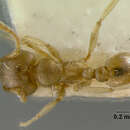en
names in breadcrumbs


Worker small, allied to Tetramorium . Antennae 12-jointed, with 3-jointed club, as long as or slightly longer than the remainder of the funiculus. Maxillary palpi 3- jointed; labial palpi 2-jointed. Head broader behind than in front, with convex sides and small, moderately convex eyes at the middle of its transverse diameter. Ocelli absent. Clypeus flattened or moderately convex, ecarinate, its anterior border entire, a little produced, narrowed on the sides and bluntly ridged in front of the small antennal foveae. Frontal carinae short and more or less diverging; frontal area large but not impressed. Scrobes absent. Thorax short and stout, convex and rounded above, with feeble or obsolete promesonotal suture, somewhat constricted or impressed at the mesoepinotal suture, the epinotum unarmed. Petiole pedunculate, the node rounded, narrower than. the postpetiole, which is transversely elliptical and rounded above. Gaster oval, formed very largely by the first segment. Legs moderately long, femora not incrassate in the middle, the middle and hind tibia; with or without short simple spurs.
Female somewhat larger than the worker, with 12-jointed antennae but differing considerably in structural details in the various species. Fore wings with a cubital, a discoidal and an open radial cell.
Male with 10-jointed antennae and elongate second funicular joint, as in Tetramorium , and closely resembling the males of this genus also in other respects. Wings as in the female.
The species of this genus are confined to the Ethiopian Region (Map 28). A few Indian forms formerly referred to the genus have been recently placed by Emery in a new genus , Acidomyrmex , characterized by having very long, straight and diverging epinotal spines.
Taxonomy. The genus Rhoptromyrmex is assigned to the tribe Tetramoriini (Bolton 2003). The genus was revised by Bolton (1986). Workers of Vietnamese species have the following features.
Worker monomorphic; head in full-face view cordate; frontal carina and antennal scrobe absent; anteromedian margin of clypeus broadly convex without any emargination at its midpoint, overhanging basal border of mandibular blade when mandibles closed, lacking an isolated median seta; posteromedian portion of clypeus very broadly inserted between frontal lobes; lateral portion of clypeus modified into a narrow and low ridge or wall in front of antennal insertion; mandible triangular; masticatory margin with apical and 1 or 2 larger preapical teeth followed by some smaller teeth or minute denticles; palp formula 3,2; antennae 12-segmented, with distinct 3-segmented club; eye relatively large; mesosoma relatively short and high; promesonotum in lateral view not or hardly raised; promesonotal suture absent dorsally; metanotal groove weakly impressed dorsally; mesopleuron marginate anteriorly with a carina that never develops into distinct flange projecting over basal part of forecoxa; propodeal spine long and spinose; propodeal lobe reduced to a low carina; petiole consisting of short and stout peduncle and relatively high node; gastral shoulder indistinct or absent; apex of sting with a small lamellate appendage; body bearing a few standing hairs which are short and blunt apically; head and mesosoma only weakly and finely rugose.
The worker of Rhoptromyrmex is similar to that of Tetramorium , but in the latter the head in full-face view is roughly oval or subrectangular, with posterolateral corners which are not or weakly produced and the propodeal lobe is well developed. In Vietnamese species of Tetramorium the palp formula is 4,3.
Vietnamese species. Three species have been found from Vietnam: wroughtonii Forel [= sp. eg-2; = sp. 1 of SKY: Eguchi et al. 2005] (Ba Vi, Cuc Phuong, Sa Pa, My Yen, Tam Dao, Tay Yen Tu, Van Ban); sp. eg-1 [= sp. 2 of SKY: Eguchi et al. 2005](Cuc Phuong, Sa Pa, Tam Dao, Tay Yen Tu); sp. eg-3 [= sp. 3 of SKY: Eguchi et al., 2005] (Tam Dao).
Bionomics. Vietnamese Rhoptromyrmex species inhabit forest edges and woody habitats, but sometimes open habitats. They nest in soil and build a large caldera-shaped entance mound with soil particles.
Tetramorium is a genus of ants in the subfamily Myrmicinae that includes more than 520 species.[1][2] These ants are also known as pavement ants.
Tetramorium was first described by Gustav Mayr in 1855 in the same publication as Monomorium.[3]
Revision within the genus by Wagner et al. in 2017 recognized a complex of 10 cryptic species, 3 of which were raised from subspecies classifications and 2 of which were newly described. This revision also elevated the pavement ant introduced to North America as the species T. immigrans rather than the previous designation as a subspecies of T. caespitum. These 10 species within in the T. caespitum complex are as follows:[4]
Workers of most species have a ridged clypeus, an appendaged stinger, mandibles with 3 or 4 teeth, and antennae with 11 or 12 segments or with 3-segmented clubs on the tips.[2] The genus is divided into several species groups defined by various characters.[2]
Most species are distributed throughout the Afrotropical and Oriental regions. Ten species have been recorded from Japan. One species of pavement ant, T. immigrans, is native to Europe and was probably introduced to North America starting in the 18th century.[5][4]
Most known species nest in the soil, in decaying wood, or in leaf litter. Some live in trees or in termite nests.[2]
{{cite journal}}: CS1 maint: multiple names: authors list (link) Tetramorium is a genus of ants in the subfamily Myrmicinae that includes more than 520 species. These ants are also known as pavement ants.